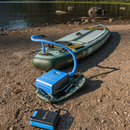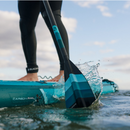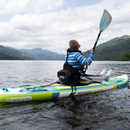Paddling the Yukon

Paddling 700km/434.96mi with Canadian native and avid adventurer Kayle Luft
Introduction - Paddling the Prospector’s Path:
In July of 2024, I set out to paddle board the Yukon River in Canada’s remote north, from Whitehorse to Dawson city. The route crossed over 720 km of wild backcountry, mirroring the historic pilgrimage undertaken by gold-crazed prospectors in the early 1900’s. The swift, cold waters propelled me through the same untamed wilderness that inspired the works of Jack London and Robert Service, where stories of adventure, hardship, and fortunes abound. It was my goal to experience a small part of this history, to pit myself and my SUP against the vast river as it surged north beneath endless summer daylight. I paddled alone through forest fires, rapids, and abandoned towns, and witnessed bears, shipwrecks, and remote natural beauty far beyond the reaches of civilization. It was a journey back in time, in a place where prospectors sought riches, and either bent or broke under the will of the wild.

Gearing Up: What to Bring for a 700km SUP
I used to view inflatable stand-up-paddleboards (SUPs) as toys – but over the past few years they have evolved to be lighter, more durable, and more reliable. My brother Evan and I have spent countless days fishing and touring on inflatable SUPs, and we dreamt up the idea of paddleboarding the Yukon River together. As is often the case, life and work got in the way, so while Evan kept the planes flying back home, I went north alone.
The uncertainty of how long the trip might take and the sheer remoteness of the route demanded careful planning. Outfitters had plenty of advice for canoeists, but none for solo paddleboarders. Everything from clothing, to fitness, to food, to protection from the animals and elements had to be considered. Once on the river in Whitehorse, there would be no cell service, and no reasonable exit until Carmacks 320km downriver. After Carmacks, I’d continue another 400km through the most remote wilderness I’d ever been, riding an ever expanding river that swelled with the addition of numerous tributaries that were themselves larger than any river I’d ever paddled before.

I packed for up to three weeks off grid – iROCKER shipped two BLACKFIN MODEL V paddle boards and their most durable carbon paddles, and while I waited, I marked the shape of the boards on my garage floor to experiment with various setups. I considered weight, balance, and redundancy for important items. I brought myriad dry bags, patch kits, a backup pump, camping gear, emergency supplies, bear spray, and a satellite SOS device. A 115L portage backpack would allow me to carry enough gear to walk out if needed, perhaps if the board was lost or destroyed. I calculated the calorie-to-weight content of various foods and filled a short, watertight barrel with a 10 day supply. I’d leave another 10 day resupply at the approximate halfway in Carmacks. The barrel doubled as a seat and served as a bear-hang when tied to my 30m of floating rope. Despite helpful advice from one northerner that “you’ll die without a wetsuit”, I opted for a waterproof shell and fast drying, wringable layers.
On the Water – Whitehorse, Thirty Mile, & Carmacks:
Arriving in Whitehorse after a 25-hour drive from Calgary, I was met with cold, wind, and rain. I passed 16 bears, 5 moose, as well as buffalo, foxes, and porcupines. The Yukon capital has a population of 30,000, and a rugged charm. I wanted first to visit the infamous Lake Laberge, and to test out my gear. As I inflated my board, I met Alex, a park warden who coincidentally was planning to canoe the first 320km of the same route. We decided to meet the next day for a coffee. We discussed logistics and agreed to set off together the following day. There is a comfort in company, even for men seeking solitude.

Lake Laberge was the first trial – a monstrous lake 50km long and 5km across. The wind was howling but at least was blowing north. We paddled close to the Eastern shore until late in the evening, where the water was rough but safer. I’m not sure which craft fared better – a SUP can easily be re-mounted in open water, but a capsized canoe would have been disastrous. I found that standing gave me more control and made better use of the wind at my back, accepting that falling into the frigid waters was inevitable. Miraculously, it never happened, despite swells that rose higher than the gunnels of Alex’s canoe. We laughed and hollered wildly – effective medicine for conditions that raised a sense of primal fear. We set up our tents at midnight, and were up again by 4:30am, raising makeshift rain-jacket sails to take advantage of the wind. In this manner we crossed Laberge, exhausted from battling the waves, but in good time.
The north end of Laberge drains into the Thirty Mile River, a fast, smooth, and scenic stretch of water that carried us swiftly northward. The river here was beautiful, winding through remote spruce-forested hills and enormous cutbanks, moving along rapidly like an emerald conveyor belt. After 15 hours of paddling, we entered a forest fire that continued for hours – the scorched, smoking earth prohibiting any chance of camping. Occasional bursts of open flame and the loud crack of falling spruce spurred us downstream until we finally made camp at 1am, the sky noticeably brighter having travelled nearly 200km north.

Over the remaining distance to Carmacks, the river grew wider and slower. I noticed my paddle strokes becoming increasingly efficient, and I became adept at cooking and eating while on the SUP. We started to notice the sound of silt hissing against our vessels. The weather was capricious – bone chilling cold and rain for 11 hours one day, heat and sun the next. The heat brought convective cloud that boiled into monstrous thunderstorms that cracked lightning and dumped oceans of rain. More than once, we took shelter under the cover of tall spruce, collecting the innermost dry branches to ignite a warming fire and dry our clothing.
Carmacks, Five Finger Rapids, and the White River
Saying goodbye to Alex in Carmacks was bittersweet. We had shared the humor and hardships of the trail for 320km – paddling 12-17hrs a day. I had made far better time than anticipated, but knew things could change rapidly and thus was eager to make miles. My parents had generously offered to make the drive to Carmacks to drop off my resupply of food, and I waved goodbye to them as I set off again alone. The enormous swirling currents occasionally broke the silence with a loud swish - the river and wilderness becoming my only companions as I paddled north.

The legendary Five Finger Rapids came next. They were a dangerous part of the journey, or so I’d been told. The water funneled between basalt pillars, and I could hear it roaring long before I saw it. I stowed and secured my gear, checked everything twice, and entered the channel on the far right. The rapids were swift, dropping into a series of waves, but I remained standing and paddled hard to keep momentum. I splashed over the worst of it, keeping left of the eddy line and plowing through the boils and currents beyond. I laughed as the danger passed quickly. Legends are often like that—bigger in the telling than in the living.
After the rapids, the river grew wider, slower. The days blended into one another, each one marked by the rhythm of the paddle and the endless sweep of the landscape. The land was incomprehensively vast, untouched. I saw many animals – bears, moose, eagles, porcupines. When I noticed a bear swimming across the river near Minto, I paddled alongside it. It snorted and panted as it worked hard against the current. Strangely, it wasn’t the first time I’ve escorted a bear across open water on a SUP, and it wasn’t the last time on this trip either. I passed many moose staring wide-eyed at my strange craft as I drifted silently by. Inevitably they would startle and crash back through the forest.

I paddled through abandoned ghost towns, past many sternwheel shipwrecks, and through two more forest fires. The weather was sunny and hot. There was no one around to see me, so I did my laundry in the river and paddled bare while it dried. When I was too hot, I floated in the water alongside the board, my lifeline the quick-release leash secured to my ankle. When my back was sore from paddling, I would turn around and face backwards on the board, pushing the paddle with my chest instead of pulling with my back.
Eventually the White River joined the Yukon, turning the water gray with silt. It hissed loudly against the board, sounding similar to an air leak. The water was thick and opaque, more like paint than water. Initially I tried to obtain drinking water using coffee filters, but discovered the silt was so fine it passed right through, so I let it settle instead and drank the clear water on top. Not being able to see into the water became a hazard, concealing shallows and sandbars, but it created mesmerizing contrasts in the water, and was manageable with caution. The wild is like that—hard but fair.
In the final days, I let myself slow down. I had made good time, and the end was close. Dawson City was within reach, but I wasn’t ready to leave the river just yet. I explored sandbars barefoot, and opted to camp one more night, the sky clear and bright in an endless orange sunset. This far north, there was no darkness anymore. There was peace in that, in the quiet of the wilderness, and I found myself lamenting the idea of leaving the river so soon.

As I rounded the final bend, Dawson City came into view. I was surprised to spot two bears, just upstream of town, one swimming across the river, the other turning tail towards the Klondike river shore. A perfect parting gift as I escorted the one back to shore. The town appeared a mix of old-time charm and northern grit – the ferry trudging across the current, and a bright red floatplane moored proudly to shore. My parents were there, cold beer in hand, and I felt a strange mix of triumph and sadness. The Yukon had been my companion, carrying me through places not often seen, and now it was time to part ways. I sat with my parents marvelling at the enormous silty river flowing indifferently and tirelessly towards the Bering Sea.
Dawson & a Sour-Toe Salute:
Dawson City was a place where the gold rush days were never far from the surface. I wandered its dirt streets, drank in its saloons, and even took a flight in the small red floatplane, buzzing through the vast river valley I had just travelled. The Yukon looked different from above—tamer, somehow, but powerful and immense. The river was as wild as ever, and I was grateful it had allowed me to pass without too much trouble.
To cap off the journey, I visited the Downtown Hotel and ordered the famous Sour-Toe Cocktail—a shot of whisky with a human toe floating in it. It was the kind of tradition that fit perfectly in such a place – the original toe having been chopped off with a woodcutting ax after rum-runner Louie Linken froze his foot solid on the winter trail. As I swirled around the blackened, dehydrated toe in the crowded bar, I felt as if I had stepped back in time. I had traveled hundreds of kilometers of the Yukon by my own paddle, bearing in small part some of the uncertainty of the early travelers and those seeking gold in the north. I drank the whisky, let the toe brush my lips, and laughed. Robert Service’s immortal words floated in my head as I stepped outside under the glowing midnight sky – “Strange things are done in the midnight sun”… indeed.






